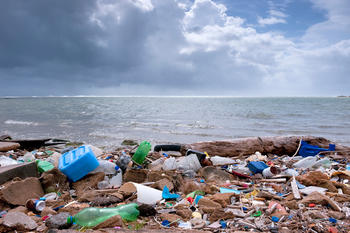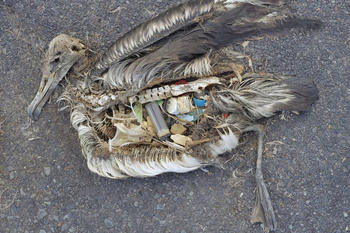The Big Cleanup
Computer scientists from Freie Universität hope to use their calculations to clear plastic waste from the world’s oceans
Mar 01, 2015
Huge amounts of trash form “garbage patches” in the world’s oceans.
Image Credit: iStockphoto/Fabio Filzi
Seabirds like the albatross mistake drifting plastic products for food – with deadly consequences.
Image Credit: Chris Jordan, cc by 2.0
Everyone knows, but no one does anything about it. Huge amounts of plastic waste are piling up at certain points in the ocean, carried there by currents. Five of these “garbage patches” have formed in the world’s oceans. There is talk of there being tens of thousands of tons of plastic trash involved: “That’s just a rough estimate of the amount,” says computer scientist Tim Landgraf of Freie Universität Berlin. “But what’s really impressive, though, is the area,” he adds.
The biggest “garbage patch,” Landgraf says, is located in the Pacific Ocean, between North America and Asia, and is estimated to rival Central Europe in size. That makes it obvious that simply crossing the trash vortex by ship and dragging nets to collect the waste would be a Sisyphean task. Fish and marine mammals would also be swept up in the nets. With all this in mind, one international project is pursuing a different plan: setting up stationary barriers at the surface of the water to trap trash. The idea is to position the barriers in locations where exceptionally large amounts of plastic float by.
Landgraf is the head of the Biorobotics Lab at the Department of Mathematics and Computer Science at Freie Universität. His actual focus is on designing robot bees and fish – almost like artificial members of a species that researchers can use to collect detailed information on bee dances or schooling behavior in fish. He became involved with the project “The Ocean Cleanup” by chance, when he happened to hear a talk given by Boyan Slat, a Dutch student, on the TEDx online platform. Slat, now just 20 years old, has decided to clean up the oceans, harnessing the power of currents to collect the trash at suitable locations. “Slat was looking for people who could simulate this kind of thing mathematically for his feasibility study,” Landgraf says.
Many Marine Animals Mistake Colorful Plastic for Food
About a hundred volunteers, many of them scientists and researchers, have signed on so far. Landgraf is among them, and it didn’t take long before he had won over two of his associates for the project as well. For their simulation, the team used the model calculations of Australian oceanologist Eric van Sebille, based on the Global Drifter Program – data from 15,000 small sensor buoys that drift around the globe, carried by ocean currents, and transmit their GPS coordinates on an ongoing basis. “We adapted the drifter model for our line of inquiry,” Landgraf explains. “Where in the oceans does so much plastic accumulate that collecting it is worthwhile there?”
To answer this question, the researchers studied how the garbage patches form. The root cause behind them is ultimately five major spiral currents, or vortices, in the ocean. These currents also cause the patches to rotate on their own axes – albeit very slowly. The Great Pacific Garbage Patch, for example, which the team focused on, takes five years to rotate. Particles on the margins of the vortex drift back out of the patch as a result of the circular motion and are carried onward by the current. With these processes as a basis, Landgraf’s team was able to calculate the ideal positions for a system, anchored on the sea floor, to capture and separate plastic.
Many experts agree that the waste cannot be recycled. The mix of various types of plastic, heavily degraded over time by exposure to sun and saltwater, is of poor quality. Its only useful purpose is as fuel to be burned to generate power. Still, the plastic has to be removed from the water – and not just for aesthetic reasons, either, scientists and researchers say. Many marine animals mistake the colorful pieces, most of which are just a few centimeters in size, for food and eat them. And that is harmful to the health of not just ocean life, but probably also the organisms at the top of the food chain – humans, that is.
This is a logical assumption, since many plastic items contain chemicals that can act much like hormones in the body. “This effect has already been proven in fish. It causes an imbalance in the sexes, favoring females,” Landgraf explains. “Many animals do not die right away after eating plastic, even though they can’t digest it. But over the generations to come, there is a risk that they will slowly die out because they no longer have enough young.”
Eliminating All the Waste Is Likely Impossible
It will probably never be possible to clean up all the garbage in the oceans. “To do that, you would have to make the floating barriers infinitely long,” Landgraf says. But a slightly V-shaped overall structure 100 kilometers long would be able to fish out a respectable 15 percent of the global total in the North Pacific, the computer scientist estimates. The effort would take about 20 years and cost at least ten million euros, not including development costs.
But “The Ocean Cleanup” does not truly start to make sense unless another problem has been solved beforehand. So far, there has been no break in the constant supply of “replenishments” for the garbage patches. In major coastal cities, most of which have landfill sites near the ocean, every gust of wind carries more scraps of plastic into the water. On top of that, there is the waste generated by illegal dumping on the high seas. Landgraf has drawn his own conclusion, renouncing plastic for himself personally. “I have practically stopped buying anything that is packaged in plastic,” he says. Meanwhile, project initiator Bojan Slat is collecting money for further studies via crowdfunding.


